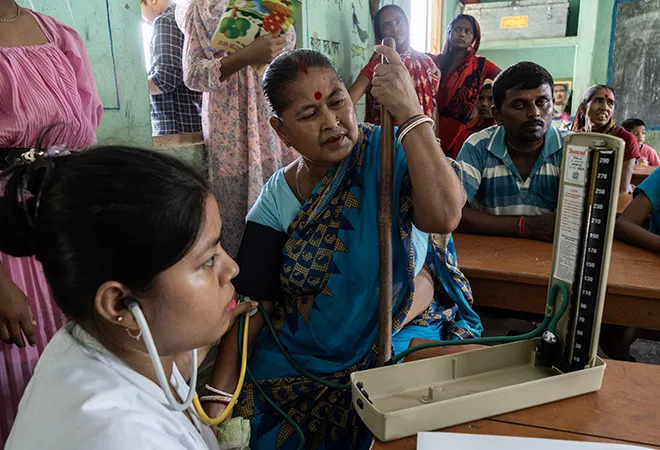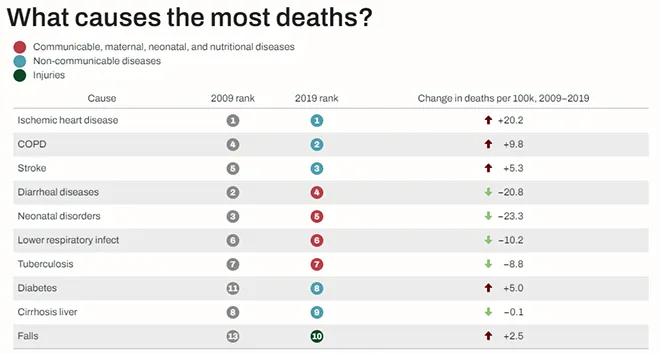
India’s
population health dynamics are multifaceted, with many social, economic, and environmental factors affecting the overall health of its people.
India’s health landscape is characterised by a two-sided disease burden, with a long-term prevalence of communicable diseases and a fast-growing prevalence of NCDs (non-communicable diseases) such as cardiovascular disease, diabetes, and respiratory diseases.
Infectious diseases such as tuberculosis, malaria and HIV/AIDS continue to be major public health threats, especially in poor and rural areas. Maternal and child health indicators continue to be worrying, with high rates of maternal and neonatal mortality, and child malnutrition.
Infectious diseases such as tuberculosis, malaria and HIV/AIDS continue to be major public health threats, especially in poor and rural areas. Maternal and child health indicators continue to be worrying, with high rates of maternal and neonatal mortality, and child malnutrition.
According to
World Health Statistics 2021, the average life expectancy is 70.8 years in India. According to the
National Family Health Survey-5, the Infant Mortality Rate (IMR) in India was 35 per 1,000 births from 2019 to 2021, which is 15 percent lower than the numbers in 2015-16. The poor IMR indicates the
underlying social determinants, such as malnutrition (35.5 percent stunting) and 19 percent wasting (low weight for height) in children under five years of age. India’s position on the
Global Hunger Index worsened from 94
th place in 2020 (out of 116 countries) to 101
st position in 2021. The
Cancer Statistics Report for 2020 indicates that the projected incidence of cancer among men in India is 94.1 per 100,000 persons and that among women, the incidence is 103.6 per 100,000 individuals. During the period 2010-2019, cancer cases increased at an annual rate of 1-1.2 percent, according to the report. However, the
prevalence of diabetes remained the same from 2015 to 2019; it is estimated that 12 percent of all men and 11 percent of all women have diabetes.
Hypertension incidence is estimated to have increased from 23 percent in 2019 to 30 percent in 2020, while the
prevalence of obesity was 22.9 and 24 percent in men and women respectively.
Figure 1: Causes of Death in India

It is evident from Figure 1 that, despite the significant changes in
India's top 10 causes of death in the decade before 2019, Non-Communicable Diseases (NCDs) still made up a significant proportion of these causes. India has experienced an epidemiological shift, with the shift of disease burden towards NCDs increasing from 30 percent to 55 percent of the overall disease burden and from 37 percent to 61 percent of deaths caused by NCDs between 1990 and 2016. To raise awareness of the risks associated with NCDs, the Ministry of Health and Family Welfare has implemented the ‘
National Programme for Prevention and Control of Cancer, Diabetes, Cardiovascular diseases and Stroke’ and set up units for screening in primary health centres across the country. Furthermore, India has been one of the first countries to adopt the World Health Organisation's (WHO) Global Action Plan for Preventing and Controlling Non-communicable Diseases 2013-2020, with a
target of 25 percent NCD reduction by 2025.
India has experienced an epidemiological shift, with the shift of disease burden towards NCDs increasing from 30 percent to 55 percent of the overall disease burden and from 37 percent to 61 percent of deaths caused by NCDs between 1990 and 2016.
It is essential to assess the
prevalence of health disparities across gender, socio-economic status, caste, and other social determinants of health to understand population health in India. District-level data on several indicators have only been made available since the NFHS-4 in 2015-16. Gender gaps, in particular, are highlighted by the lack of information on adolescent girls, despite the availability of reliable data from the NFHS and the Sample Registration System (SRS).
Education-related data girls who are subject to various forms of marginalisation, due to their religion, ethnicity or disability, are also missing.
Various health-related initiatives and policies are in place to address social determinants of health in India. The
Swachch Bharat Mission, for instance, has been instrumental in preventing the spread of diarrheal diseases among children, improving the safety and well-being of women, and improving hygiene and sanitation by reducing water and food contamination. The
Pradhan Mantri Jan Arogya Yojana aims at reducing the cost of healthcare amongst poor and vulnerable people (people below the poverty line) and the
Pradhan Mantri Ujjwala Yojana aims to provide clean fuel for cooking, especially to the population sections mentioned above, which helps in reducing the incidence of asthma and the mortality burden. Other initiatives, such as the
Pradhan Mantri Kisan Samman Nidhi (income support scheme) help in improving food security and small and marginal farmers' livelihoods as well as other irrigation schemes and schemes such as soil health cards, crop insurance, etc. There is a strong and positive correlation between education, child growth, and health outcomes. The government has also introduced programmes for children, especially girls, like the
Integrated Child Development Services Scheme from the time they are born to improve their cognitive development, nutrition, and health.
Beti Bachao, Beti Padhao is another important initiative that aims to prevent sex-selective elimination to ensure the girl child's survival, protection, and empowerment, which can have a positive impact on their health.
Other initiatives, such as the Pradhan Mantri Kisan Samman Nidhi (income support scheme) help in improving food security and small and marginal farmers' livelihoods as well as other irrigation schemes and schemes such as soil health cards, crop insurance, etc.
The
Global Health Initiative launched by the WHO in 1995 has highlighted the importance of health programmes in schools in significantly improving health outcomes. India has the largest adolescent population in the world—253 million between the ages of 10-19—and the empowerment of this population contributes to the development of the country. In 2014, the Ministry of Health and Family Welfare launched a programme called
Rashtriya Kishor Swasthya Karyakram to ensure the holistic development of this population through its health promotion approach. The
New Education Policy 2020 focuses on a comprehensive school curriculum that encompasses sports and fitness through the incorporation of physical activity in the pedagogical method, the use of 'bagless' days to encourage students to participate in professional and sporting activities, the inclusion of yoga, health and well-being, sports clubs, etc. To provide adequate nutrition and food to children, mid-day meals are served through the
Mid-Day Meal Scheme or PM POSHAN in the government and government-aided schools.
The
social determinants of health (SDHs) are increasingly being addressed in policy through flagship initiatives across various sectors. However, the prevalence of NCDs linked to lifestyle changes and new pathogens is on the rise. A lack of health equity, and poor health education and awareness have further led to poor health outcomes and social well-being. Programmes need to be more focused at the policy formulation and implementation stage to improve the various SDHs. A comprehensive approach would help to sustain the health system, raise awareness of rights, encourage community involvement and self-reliance, and strengthen local political structures and grassroots initiatives.
Shoba Suri is a Senior Fellow at the Observer Research Foundation.
The views expressed above belong to the author(s). ORF research and analyses now available on Telegram! Click here to access our curated content — blogs, longforms and interviews.



 India’s
India’s 
 PREV
PREV


